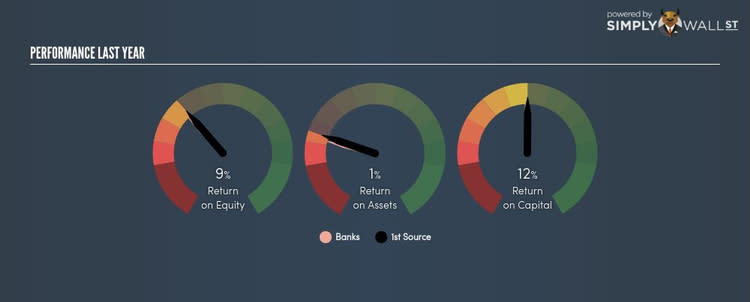What You Must Know About 1st Source Corporation’s (SRCE) ROE

1st Source Corporation (NASDAQ:SRCE) delivered an ROE of 9.46% over the past 12 months, which is an impressive feat relative to its industry average of 8.92% during the same period. On the surface, this looks fantastic since we know that SRCE has made large profits from little equity capital; however, ROE doesn’t tell us if management have borrowed heavily to make this happen. In this article, we’ll closely examine some factors like financial leverage to evaluate the sustainability of SRCE’s ROE. View our latest analysis for 1st Source
What you must know about ROE
Return on Equity (ROE) weighs SRCE’s profit against the level of its shareholders’ equity. An ROE of 9.46% implies $0.09 returned on every $1 invested. While a higher ROE is preferred in most cases, there are several other factors we should consider before drawing any conclusions.
Return on Equity = Net Profit ÷ Shareholders Equity
ROE is assessed against cost of equity, which is measured using the Capital Asset Pricing Model (CAPM) – but let’s not dive into the details of that today. For now, let’s just look at the cost of equity number for SRCE, which is 11.27%. This means SRCE’s returns actually do not cover its own cost of equity, with a discrepancy of -1.81%. This isn’t sustainable as it implies, very simply, that the company pays more for its capital than what it generates in return. ROE can be dissected into three distinct ratios: net profit margin, asset turnover, and financial leverage. This is called the Dupont Formula:
Dupont Formula
ROE = profit margin × asset turnover × financial leverage
ROE = (annual net profit ÷ sales) × (sales ÷ assets) × (assets ÷ shareholders’ equity)
ROE = annual net profit ÷ shareholders’ equity
Essentially, profit margin shows how much money the company makes after paying for all its expenses. Asset turnover reveals how much revenue can be generated from SRCE’s asset base. Finally, financial leverage will be our main focus today. It shows how much of assets are funded by equity and can show how sustainable SRCE’s capital structure is. Since financial leverage can artificially inflate ROE, we need to look at how much debt SRCE currently has. Currently the debt-to-equity ratio stands at a reasonable 63.59%, which means its above-average ROE is driven by its ability to grow its profit without a significant debt burden.
What this means for you:
Are you a shareholder? SRCE exhibits a strong ROE against its peers, however it was not high enough to cover its own cost of equity this year. However, investors shouldn’t despair since ROE is not inflated by excessive debt, which means SRCE still has room to improve shareholder returns by raising debt to fund new investments. If you’re looking for new ideas for high-returning stocks, you should take a look at our free platform to see the list of stocks with Return on Equity over 20%.
Are you a potential investor? If you are considering investing in SRCE, basing your decision on ROE alone is certainly not sufficient. I recommend you do additional fundamental analysis by looking through our most recent infographic report on 1st Source to help you make a more informed investment decision.
To help readers see pass the short term volatility of the financial market, we aim to bring you a long-term focused research analysis purely driven by fundamental data. Note that our analysis does not factor in the latest price sensitive company announcements.
The author is an independent contributor and at the time of publication had no position in the stocks mentioned.


